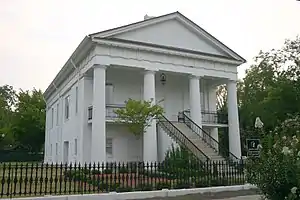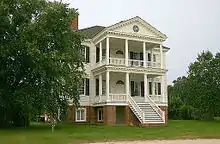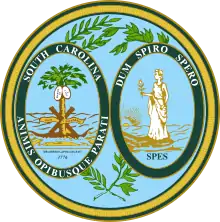Camden, South Carolina
Camden is a city in Kershaw County, South Carolina, United States. It is the largest city and county seat of Kershaw County. The population was 6,838 in the 2010 census and an estimated 7,196 in 2018. It is part of the Columbia, South Carolina, Metropolitan Statistical Area. Camden is the oldest inland city in South Carolina, and home to the Carolina Cup and the National Steeplechase Museum.
Camden, South Carolina | |
|---|---|
 Original Kershaw County courthouse in Camden | |
| Nickname(s): Steeplechase Capital of the World | |
| Motto(s): Classically Carolina | |
 | |
| Coordinates: 34°15′33″N 80°36′33″W | |
| Country | United States |
| State | South Carolina |
| County | Kershaw |
| Founded | March 22, 1786 |
| Government | |
| • Type | City manager-council |
| • Mayor | Alfred Mae Drakeford |
| Area | |
| • Total | 11.87 sq mi (30.75 km2) |
| • Land | 11.08 sq mi (28.70 km2) |
| • Water | 0.79 sq mi (2.05 km2) |
| Elevation | 187 ft (57 m) |
| Population (2010) | |
| • Total | 6,838 |
| • Estimate (2019)[2] | 7,220 |
| • Density | 651.57/sq mi (251.58/km2) |
| Time zone | UTC−5 (Eastern) |
| • Summer (DST) | UTC−4 (Eastern) |
| ZIP codes | 29020, 29021 |
| Area code(s) | 803, 839 |
| FIPS code | 45-10855[3] |
| GNIS feature ID | 1247113[4] |
| Website | cityofcamden |
Geography
Camden is in northeastern South Carolina, in the south-central part of Kershaw County. It sits on the northeast side of the Wateree River, a south-flowing tributary of the Santee River. According to the United States Census Bureau, Camden has a total area of 11.39 square miles (29.49 km2), of which 10.68 square miles (27.66 km2) are land and 0.71 square miles (1.83 km2), or 6.21%, are water.[5]
U.S. Route 521 runs through downtown as Broad Street, leading 29 miles (47 km) southeast to Sumter, and 76 miles (122 km) north to Charlotte, North Carolina. US 601 runs with US 521 through downtown, leading 21 miles (34 km) north with US 521 to Kershaw, and south on its own 50 miles (80 km) to St. Matthews and 63 miles (101 km) to Orangeburg. US Route 1 (DeKalb Street) intersects with US 521 and 601 in downtown, leading 32 miles (51 km) southwest to the state capital, Columbia, and 61 miles (98 km) northeast to Cheraw. Interstate 20 passes 2 miles (3 km) south of the city's center; it leads east 50 miles (80 km) to Florence and southwest to Columbia.
Neighborhoods
- East Camden
- Knights Hill
- Dusty Bend
- Windsor Heights
- White Gardens
- Arrowwood
- The RaceTracks
History
Colonial years
Camden is the oldest inland city and fourth oldest city in South Carolina. It is near the center of the Cofitachequi chiefdom that existed in the 1500s.[6] In 1730, Camden became part of a township plan ordered by King George II. Kershaw County's official website states, "Originally laid out in 1732 as the town of Fredericksburg in the Wateree River swamp (south of the present town) when King George II ordered eleven inland townships established along South Carolina's rivers, few of the area settlers chose to take lots surveyed in the town, choosing the higher ground to the north. The township soon disappeared." In 1758, Joseph Kershaw from Yorkshire, England, came into the township, established a store and renamed the town "Pine Tree Hill". Camden became the main inland trade center in the colony. Kershaw suggested that the town be renamed Camden, in honor of Lord Camden, a champion of colonial rights in the British Parliament.[7] In the 1770s it was the site of an early American porcelain factory, established by John Bartlam
American Revolution
May 1780 brought the American Revolution to Charleston, South Carolina, when it fell under the Crown's control. Lord Charles Cornwallis and 2,500 of his Loyalist and British troops marched to Camden and established there the main British supply post for the Southern campaign. The Battle of Camden, the worst American defeat of the Revolution, was fought on August 16, 1780, near Camden, and on April 25, 1781, the Battle of Hobkirk's Hill was fought between about 1,400 troops led by General Nathanael Greene and 950 Loyalists and British soldiers led by Lord Francis Rawdon. The latter battle was a costly win for the British, and forced them to leave Camden and retreat to the coast. After the Revolution, Camden's prominence and wealth grew as a major interior trading town with direct ties to Charleston and the world. Regional products, augmented with goods from the interior of North Carolina and far lands to the west were transported from Camden to Charleston on flat-bottom riverboats that plied the adjacent Wateree River before the railroad arrived in 1842.
American Civil War and later years
Camden was the source of six Confederate generals during the American Civil War. Richard Rowland Kirkland – "The Angel of Marye's Heights" – is interred in the Old Quaker Cemetery. At the end of the war, components of Sherman's army burned Confederate and nearby properties, including a full block of downtown buildings. The last Federal officer killed in the Civil War was 1st Lt E.L. Stevens of the 54th Massachusetts Infantry who died in a skirmish 9 miles south of Camden at the Battle of Boykin's Mill on April 18, 1865.
Starting in the mid-1880s the Camden area became an increasingly popular destination for wealthy northern families to spend the winter. Eventually three resort hotels provided winter tourism activities well into the 1930s and beyond. The town became associated with many equestrian activities, and is now the home of the third oldest active polo field in America. In the winter, more than 1,500 thoroughbreds call the area home. According to Kershaw County's web site, "Horse related activities became very popular. That interest in equine activities has continued and today the horse industry is a major part of the county economy. For that reason, the city is known as the 'Steeplechase Capital of the World'."

In 1950, Dupont opened the Dupont May Plant in Camden which manufactured Orlon. The plant was located on five miles of land and employed over 2,000 people.[8][9] For many years it was the town's largest employer.[10] In 1977, DuPont notified the National Institute for Occupational Safety and Health of a study the company conducted which showed an "excessive incidence and cancer mortality" rate among a cohort of workers who worked at the plant from 1950 to 1955.[11] The findings were liked to a major chemical component of Orlon, acrylonitrile.[12] Citing issues with foreign competition, Dupont ended the production of Orlon in 1990.[13] Since the closure of the Orlon plant, the town has attracted a number of manufacturing companies such as Hengst GmbH & Co. and Haier.[14] In 2003, Target opened an $85 million distribution center in the town.[13]
Demographics
| Historical population | |||
|---|---|---|---|
| Census | Pop. | %± | |
| 1850 | 1,133 | — | |
| 1860 | 1,621 | 43.1% | |
| 1870 | 1,007 | −37.9% | |
| 1880 | 1,780 | 76.8% | |
| 1890 | 3,533 | 98.5% | |
| 1900 | 2,441 | −30.9% | |
| 1910 | 3,569 | 46.2% | |
| 1920 | 3,930 | 10.1% | |
| 1930 | 5,183 | 31.9% | |
| 1940 | 5,747 | 10.9% | |
| 1950 | 6,986 | 21.6% | |
| 1960 | 6,842 | −2.1% | |
| 1970 | 8,532 | 24.7% | |
| 1980 | 7,462 | −12.5% | |
| 1990 | 6,696 | −10.3% | |
| 2000 | 6,682 | −0.2% | |
| 2010 | 6,838 | 2.3% | |
| 2019 (est.) | 7,220 | [2] | 5.6% |
| U.S. Decennial Census | |||
As of the census[3] of 2010, there were 6,838 people living in the city limits, in 2,967 households and 1,800 families. The population density was 692.2 people per square mile (267.4/km2). There were 3,544 housing units at an average density of 331.8 per square mile (127.9/km2). The racial makeup of the city was 62.2% White, 35.1% African American, 0.20% Native American, 0.7% Asian, 0% Pacific Islander, 2.7% from other races, and 1.1% from two or more races. Hispanic or Latino people of any race were 2.4% of the population.
There were 2,967 households, out of which 27.7% had children under the age of 18 living with them, 41.1% were married couples living together, 16.5% had a female householder with no husband present, and 36.3% were non-families. 35.6% of all households were made up of individuals, and 18.9% had someone living alone who was 65 years of age or older. The average household size was 2.26 and the average family size was 2.94.
In the city, the population was spread out, with 21.9% under the age of 18, 20.1% from 18 to 39, 34.5% from 40 to 64, 17.3% from 65 to 84, and 4.3% who were 85 years of age or older. The median age was 45.3 years. 45.0% of the population was male and 55.0% of the population was female.

The median income for a household in the city was $48,313, and the median income for a family was $62,140. Males had a median income of $42,597 versus $32,524 for females. The per capita income for the city was $26,385. About 13.7% of families and 15.4% of the population were below the poverty line, including 19.3% of those under age 18 and 13.2% of those age 65 or over.
Government
Camden has a city manager–council form of government. Alfred Mae Drakeford, an African American woman, was elected mayor of Camden in November 2016. Camden is represented in the South Carolina Senate by Vincent Sheheen, who was born in Camden. It is part of South Carolina's 5th Congressional District, which is represented by Ralph Norman.
Education

The Kershaw County School District is the governing body of the public schools in the area. The district operates Pine Tree Hill Elementary School, Jackson Elementary School, Camden Elementary School, Woolard Technology Center (WTC), Camden Middle School, and Camden High School.
Camden Military Academy, the Montessori School of Camden, and Cornerstone Christian School are private institutions.
Central Carolina Technical College has two branches located in Camden.
Camden has a public library, a branch of the Kershaw County Library.[15]
Arts and culture
The Carolina Cup is an annual event held on either the final Saturday in March or the first Saturday of April. The first race was held on March 22, 1930, and has been held every year since, with the exception of 1943 and 1945 during World War II and 2020 due to the coronavirus. The races have become a South Carolina tradition, and normally draw a crowd of over 70,000 spectators. "The Cup" has become a premier social sporting event in Camden and in South Carolina. The race is held at the Springdale Race Course, just north of Camden. The National Steeplechase Museum is located near the course. Among major steeplechase horse races, the Carolina Cup is unique that in South Carolina state law prohibits gambling on horse racing.
Held annually on the first Saturday of March, Irish Fest Camden draws over 2,000 visitors to its celebration of Saint Patrick's Day and Irish and Celtic culture. Founded in 2017, the festival features live Irish music and dancing, the Lucky Leprechaun 5K race, heavy event athletics, a kids zone, arts & crafts, a Medieval/Renaissance encampment, Irish wolfhounds, Gypsy Vanner horses, exotic birds, food trucks, and festive green beer.[16]
Revolutionary War Field Days is the signature event of Historic Camden, held the first full weekend of November since 1970.[17] Hundreds of reenactors from across the country converge on the grounds to camp, battle, and celebrate over the weekend. Visitors have a chance to be a spectator for a battle each day, and they will be able to walk through the camps of the combatants while seeing demonstrations of Colonial crafts and skills. Colonial sutlers (merchants) and scholars giving talks about the war are on site as well. More than 3,400 spectators and 350 reenactors and demonstrators attended the 2017 event.
Transportation
- Seaboard Air Line Railway Depot
- Woodward Field (Kershaw County Airport)
Media
The Chronicle-Independent has served as the local newspaper of Camden since 1889. WPUB-FM is a radio station licensed to Camden that broadcasts oldies format. WCAM 1590 is another radio station licensed to Camden, which broadcasts in adult standards format.
Notable people
- Thomas Austin, NFL player
- Bernard Baruch, financier and presidential adviser
- Charles Bennett, NFL player
- Brook Benton, singer
- Mary Chesnut, author and Civil War diarist
- Larry Doby, first African American to play in the American League, member of Baseball Hall of Fame
- Bobby Engram, NFL player
- Vonnie Holliday, NFL player
- Lorenzo James, 19th-century politician
- Joseph Brevard Kershaw (1822–1894), lawyer, judge and general
- Michael Kohn, Major League Baseball player
- Kathleen Parker, journalist, winner of 2010 Pulitzer Prize for commentary; resident of Camden
- Vincent Sheheen, state senator and 2010 Democratic nominee for governor
- John C. West, Governor of South Carolina (1971–1975)
- Lois Rhame West, First Lady of South Carolina (1971–1975), first woman to chair the Muscular Dystrophy Association[18]
- Richie Williams, CFL player
- Samuel E. Wright, actor and Broadway performer
- Hastings Wyman, political consultant, journalist, and author; resided part of his childhood in Camden
- Shawn Elliott, Head Collegiate Coach, Georgia State University
References
- "2019 U.S. Gazetteer Files". United States Census Bureau. Retrieved July 29, 2020.
- "Population and Housing Unit Estimates". United States Census Bureau. May 24, 2020. Retrieved May 27, 2020.
- "U.S. Census website". United States Census Bureau. Retrieved January 31, 2008.
- "US Board on Geographic Names". United States Geological Survey. October 25, 2007. Retrieved January 31, 2008.
- "Geographic Identifiers: 2010 Census Summary File 1 (G001), Camden city, South Carolina". American FactFinder. U.S. Census Bureau. Archived from the original on February 13, 2020. Retrieved April 17, 2019.
- Charles Hudson (September 1998). Knights of Spain, Warriors of the Sun: Hernando de Soto and the South's Ancient Chiefdoms. University of Georgia Press. pp. 234–238. ISBN 978-0-8203-2062-5. Retrieved February 16, 2012.
- Federal Writers' Project (1941). Palmetto Place Names. Sloane Printing Co. p. 31.
- "History of Orion, Details Of Camden Plant." The State. June 16, 1950. Received from https://dspace.ychistory.org/bitstream/handle/11030/71910/00000929.pdf?sequence=1
- "DuPont May Plant in Camden, South Carolina | Hagley Digital Archives". digital.hagley.org. Retrieved June 26, 2020.
- "Fostering Goodwill with Jobs." Evelyn Iritani. July 31, 2005. The LA Times. Accessed from https://www.latimes.com/archives/la-xpm-2005-jul-31-fi-uschina31-story.html on June 25, 2020.
- "Current intelligence bulletin 18 - acrylonitrile". October 16, 2018. doi:10.26616/NIOSHPUB7812718. Cite journal requires
|journal=(help) - Colby, Gerard, 1945- (1984). Du Pont dynasty. Colby, Gerard, 1945-. Secaucus, N.J.: L. Stuart. ISBN 0-8184-0352-7. OCLC 10725106.CS1 maint: multiple names: authors list (link)
- "Du Pont plans to discontinue Orlon fiber". UPI. Retrieved June 26, 2020.
- Haier Group in Camden, SC. Travel and Industry Development. Received from https://www.tradeandindustrydev.com/industry/manufacturing/haier-group-%E2%80%94-camden-south-carolina-2308
- "Locations & Hours". Greenville County Library System. Retrieved June 8, 2019.
- Irish Fest Camden
- Revolutionary War Field Days
- O'Mara, Dan (May 6, 2014). "Winthrop alum Lois Rhame West, former SC first lady and 'bright light,' dies". The Herald (Rock Hill). Archived from the original on July 14, 2014. Retrieved July 13, 2014.
Further reading
- Inabelt, Joan & L. Glen Inabinet, A History of Kershaw County, South Carolina. (University of South Carolina Press, 2011). 718 pg. See pp. 90, 237, 271, 328, 398, 427,431, 433, 538, 558–59.
- Lewis, Kenneth E. The Carolina Backcountry Venture: Tradition, Capital, and Circumstance in the Development of Camden and the Wateree Valley, 1740—1810 (University of South Carolina Press, 2017). xviii, 436 pp.
- Stokes, Karen D., ed. "Sherman's Army Comes to Camden: The Civil War Narrative of Sarah Dehon Trapier", South Carolina Historical Magazine, 109 (April 2008), 95–120.
External links
| Wikimedia Commons has media related to Camden, South Carolina. |

